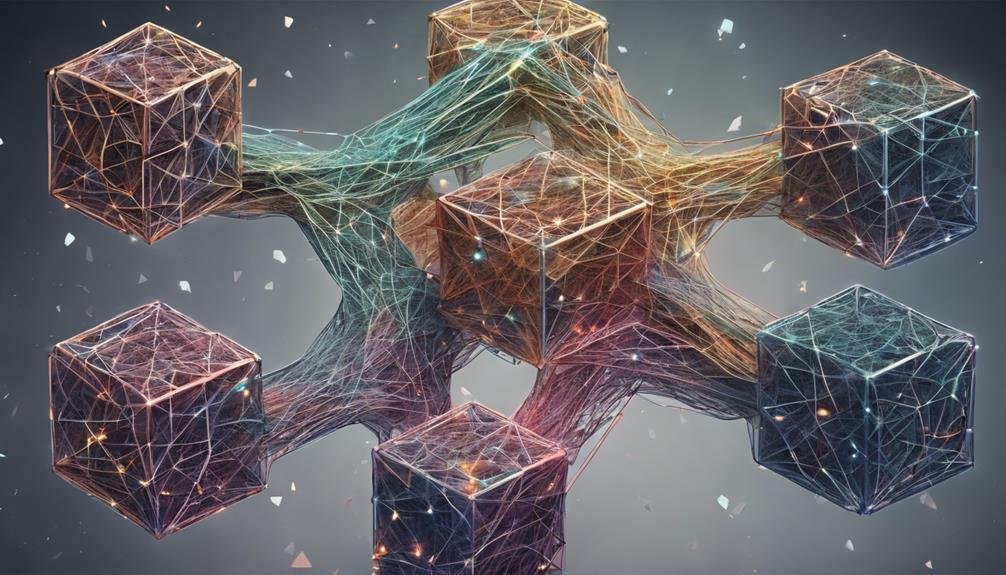Brief Overview of Blockchain Technology In NFT Verification
- Digital signatures verify authenticity and ownership.
- Encrypted hashes prevent duplication and ensure security.
- Blockchain explorers offer transparent transaction history.
- Cryptographic codes act as unique digital fingerprints.
- Immutable records on blockchain deter fraudulent activities.
Blockchain employs digital signatures, encrypted hashes, and blockchain explorers to validate non-fungible token authenticity. Digital signatures function as digital fingerprints, boosting security and trust. Encrypted hashes authenticate transactions uniquely and deter fraud. Blockchain explorers provide transparency by displaying transaction logs and metadata. They offer a comprehensive history of ownership changes and asset details.
By utilizing these mechanisms, blockchain guarantees a secure and transparent process for verifying non-fungible tokens. Learning about these tools can deepen your understanding of how blockchain validates authenticity. Further insights into this process can broaden your knowledge in this area.
Digital Signatures for Verification
Utilizing digital signatures in NFT validation enhances security and trust within the blockchain ecosystem. Digital signatures serve as unique cryptographic codes that verify the authenticity and ownership of non-fungible tokens (NFTs). These signatures act as a digital fingerprint, ensuring the integrity and originality of each NFT by confirming its provenance through transaction metadata and data. By validating the digital signature of an NFT, users can prevent unauthorized duplication, track its transaction history, and establish trust in the digital art market.
Digital signatures play a vital role in reducing the risks associated with fraud, counterfeiting, and unauthorized replication of digital collectibles on the blockchain. It plays an important role in enhancing the security of NFTs, providing a reliable method for verifying ownership and authenticity. Digital signatures are essential in maintaining the transparency and trustworthiness of NFT transactions, ultimately contributing to the overall integrity of the blockchain ecosystem.
Encrypted Hashes for Security

Encrypted hashes play a vital role in maintaining the trust and transparency of NFT transactions, as they provide a robust mechanism for validating the authenticity of each digital asset on the blockchain. These encrypted fingerprints serve as unique digital identifiers within NFTs, ensuring security and authenticity by preventing duplication and verifying ownership on the blockchain.
Each NFT possesses a distinct cryptographic hash that acts as a secure identifier, created through cryptographic algorithms to safeguard integrity and ownership. By verifying the encrypted hash of an NFT, you can confirm its originality and validate ownership, offering a tamper-proof method to secure NFTs and deter fraudulent activities in the digital asset world. These encrypted fingerprints are essential in safeguarding the integrity of NFT ownership records and ensuring that fraudulent activities are minimized, fostering a secure environment for creators and collectors alike.
Blockchain Explorers for Transparency

Blockchain explorers like Etherscan offer users a transparent view of NFT transactions and metadata details. Through platforms like Etherscan, you can verify the authenticity of an NFT by analyzing its blockchain transaction logs and metadata. Etherscan provides:
- A complete transaction history of an NFT.
- Showing essential information such as minting time.
- Creator details.
- Ownership changes.
Utilizing blockchain explorers guarantees the reliability of NFTs as they offer an immutable record of ownership and transaction history. Etherscan’s interface allows you to investigate NFT ownership, asset specifics, and rarity, enhancing transparency in the NFT ecosystem. With these tools, users can track and understand the flow of NFT transactions, enabling them to make informed decisions regarding NFT purchases or sales.
Embracing blockchain explorers like Etherscan empowers you to explore further into the authenticity and ownership of non-fungible tokens, fostering a more transparent and secure environment for NFT transactions.
Frequently Asked Questions
How Does Blockchain Verify Authenticity?
Blockchain technology verifies authenticity by utilizing digital signatures and token metadata. Immutable records ascertain ownership proof through secure verification. Smart contracts, decentralized networks, consensus algorithms, and timestamped transactions further enhance the process of confirming authenticity.
How Do You Verify the Authenticity of Nft?
To verify the authenticity of an NFT, you’ll investigate its unique identifiers, examine digital signatures, and explore ownership records. The blockchain’s immutable ledger will guide you through decentralized verification, ensuring legitimacy.
How Can NFTS Be Used for Authentication?
To authenticate NFTs, token uniqueness and digital signatures are utilized for ownership verification. Immutable records and smart contracts guarantee decentralized validation. Proof of ownership and trustless transactions are confirmed through a verification process, maintaining a secure chain of custody.
What Technology Does Crypto Art NFTS Rely on to Validate Authenticity?
Crypto art NFTs rely on decentralized verification, immutable ledgers, smart contracts, digital signatures, proof of ownership, token standards, consensus mechanisms, art provenance, supply chain, and digital scarcity to validate authenticity, ensuring transparency and security.
Conclusion
To sum up, blockchain technology offers a secure and transparent way to validate the authenticity of non-fungible tokens. Users can be assured of the legitimacy of their digital assets by utilizing digital signatures, encrypted hashes, and blockchain explorers. Like a skilled detective uncovering the truth behind a mystery, blockchain provides the tools needed to verify the uniqueness and provenance of NFTs. Trust in the blockchain and reveal the hidden treasures of the digital world.










